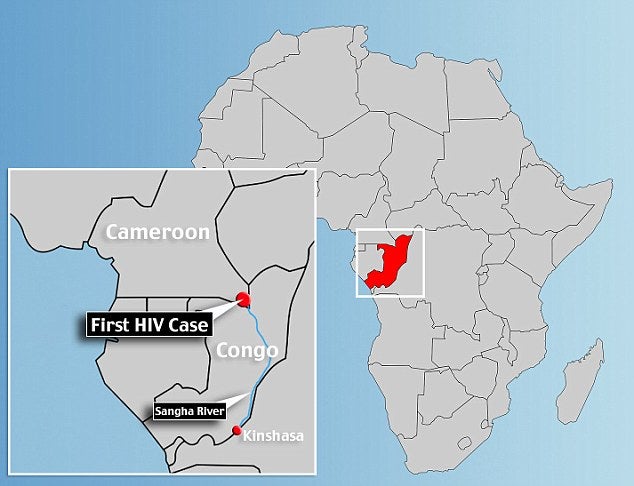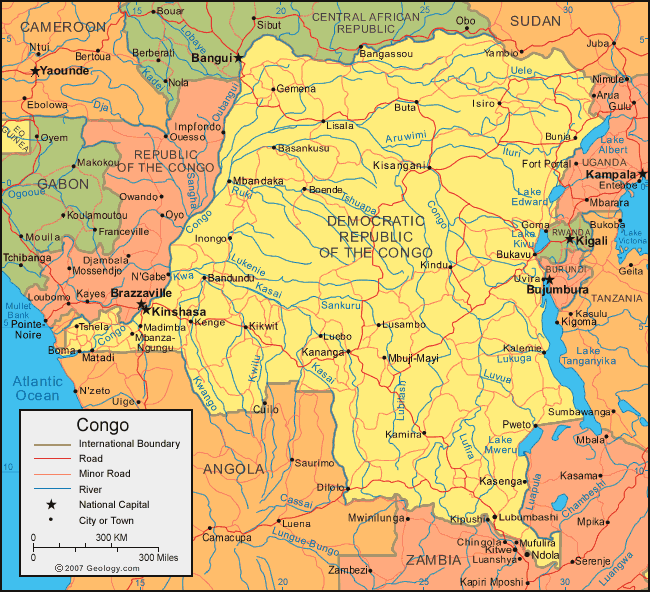(Revised 5 March 2015)
Definitions, Origins, and Prevalence
Some Acronyms
- AIDS
- Acquired
- Immunodeficiency
- Syndrome
- HIV
- Human
- Immunodeficiency
- Virus
Acquired
-
- AIDS is acquired as the result of a viral infection with HIV. Other immune deficiency syndromes can be hereditary or induced. Thus HIV is an essential part of the definition of AIDS.
Immune Deficiency
-
- An infection with HIV usually has few serious symptoms in its early stages — a mild flu and some swollen glands, typically.
Slowly but surely, the HIV infection destroys the ability to mount a protective immune response by killing a special set of cells called T4 lymphocytes (or CD4)
The body is then defenseless vs. infections
Syndrome
-
- AIDS is a collection diseases, called opportunistic infections that are often the real cause of disease and death
- HIV does not cause those diseases, they are the result of the loss of immune defenses
- The specific subset of opportunistic infections varies with the individual.
Disease vs. Syndrome
- “HIV disease” refers to the direct effects of the HIV infection, mostly the infection and death of CD4 cells (and a few other types) as well as a later infection of other tissues such as brain.
- AIDS (a syndrome) is an umbrella for the diseases that occur because of the prior effects of HIV disease (plus a few direct effects of HIV)
- AIDS is defined by its effects, by a set of symptoms plus a requirement (added more recently) for the presence of HIV
- HIV disease is defined by its cause, infection with one or more of the Human Immunodeficiency Viruses
Changing Terminology
- AIDS definitions have changed over time
- difficulties for statistical measures
- Political Correctness led to confusion for a while
- exposed = at risk
- infected = exposed
- diseased (patient) = living with (PLWA)
HIV Terms
- Retrovirus
- RNA (virus’s genetic material) copied into DNA
- DNA goes to cell’s chromosomes and becomes a gene — something that all descendants will have
- two kinds of retrovirus
- oncornavirus (cause cancer)
- lentivirus (“slow” viruses, includes HIV)
HIV has several subtypes
- HIV-1: common in most of the world (almost the only form found in the US)
- spread from central Africa
- probably first entered humans about 1950 or a bit earlier
- oldest knows case (retrospective) 1959
- about 10 subtypes
- HIV-2: Confined mostly to West Africa
- less virulent, but spreading
Origin of HIV
Origin of HIV-2
- Sooty mangaby monkey of West Africa
- HIV-2 is much more like SIVsm than it is like HIV-1
- How is crossed is unknown
- slaughter of monkeys to feed the lumbermen in the area?
- no real information
Origin of HIV-1
- HIV-1 comes from Chimpanzees.
- Three different transfers
- probably happened about 1900 in Africa
- first documented death is 1959 in Leopoldville, Belgian Congo (now Kinshasa, Zaire)
- similar to the common ancestor of subtypes B and D
- B is most common in Europe and US
Evolutionary tree for HIV
Timeline for AIDS
- HIV-1 probably crossed to humans about 1900 (plus or minus 10 years)
- First known death from AIDS, 1959
- First AIDS death in Europe
- Danish surgeon who worked in Zaire
- First AIDS cases in US 1981
- Gay men in Los Angeles and New York
- First confirmed US death, 1969
- 15-yr old male prostitute with HIV
- HIV antibodies found in frozen tissue samples
- 15-yr old male prostitute with HIV
1880-1918
- German colonization of Cameroon
- Rubber and Ivory
- Transported by the Sangha River to Leopoldville (Kinshasa) on the Congo River
- Slave labor forced to live off the land
- Germany ceded Cameroon after WWI
- Rubber price collapsed
- Sangha route much less important
- route from site of first transfer closed
- Map of first transfer from Cameroon to Kinshasa

- Another map of the region

1920-1960
- Belgian Congo
- Property of King Leopold II from 1877-1908
- Belgian Congo 1908-1960
- 1920-1940 a time of commerce and railroads
- By 1940, Kinshasa was a boomtown with lots of commerce
- “Wild west” type of place
- Lots of spread of HIV within Kinshasa
1960 to present
- Wars of independence
- Transport and trade collapsed
- Window of opportunity for tansfer of HIV from Kinshasa to rest of Africa closed
And so….
- Unique circumstances allowed a pandemic spread of HIV throughout Africa
- Origin in Cameroon
- Slaves carry ivory and rubber along Sangha to Leopoldville (Kinshasa) in (Belgian) Congo
- Boomtown leads to spread through the city
- Roads and railroads spread to other parts of Africa
- But then chaos closes the normal paths for transfer
And then, Out of Africa
- Independence in 1960 led to expulsion of francophone Belgian administrators
- No local administrators, so influx of Haitians
- Return to Haiti (subtype B) and spread there
- Then to USA
Indentification of AIDS
“Official Start Date”
- Michael Gottlieb’s paper in MMWR, June 1981. Pneumocyctis pneumonia (PCP) in (gay) men in Los Angeles
- Followed by others on Kaposi’s sarcoma and PCP.
- Usually marked as the first recognition of the pandemic.
34 years later
- Global total: about 60-70 million infected so far
- about 20-30 million of those have died
- US totals: about 1.7 million infected so far,
- about 1 million estimated to be LIVING with HIV
- only about 600,000 reported, rest are from estimates
- about 42,000 new infections per year
- about 1 million cases of AIDS so far, about half-million deaths so far (2004).
- about 1 million estimated to be LIVING with HIV
Comparisons worth considering
- Influenza pandemic of 1918-1919
- 20 – 40 million deaths from 1 billion infections
- Black death
- ?? 30 million??
- Tuberculosis
- 3.5 million deaths per year
- Malaria
- 3 million deaths per year
Trends 30 years later
- In US, new infections are leveling off
- AIDS cases dropping
- but new HIV infections constant at 50,000/yr
- Mortality from AIDS dropping (drugs)
- In “Third World”, the curve is still exponentially increasing
- In 1980, about twice as many adults in Sub-Saharan Africa were HIV infected as in the US
- In 1998, it was fourteen times as many!
- In US, peak of infections was early 1980’s
- about 150,000 – 200,000 new infections per yr.
- since 1995, constant at 50,000 new per yr. (incresasing?)
Some worldwide estimates:
Total infections to date (ca. 75 million?)
- North America: 2 million
- Latin America: 3 million
- Western Europe: 1.3 million
- Sub-Saharan Africa: more than 57 million
- South and Southease Asia: 9 million
Global Summary as of December 2011
- Persons living with HIV: 34 million (about 50% are women)
- Persons newly infected with HIV in 2011: 2.5 million
- AIDS deaths in 2011: 1.7 million (down from 2.1 million just 5 years earlier)
“If an aspirin and a glass of clean water could cure AIDS, 90% would still die”
Some Sobering Facts
- In 2011, 1.7 million AIDS deaths but 2.5 million new infections
- In 2007, our best estimates say that 95% of all those infected with HIV will die of AIDS. (A bit lower now wiht drugs)
- So the number of deaths per year MUST rise for many years, no matter what else happens!
US data
- Sharp peak of HIV infections in early 1980s
- Infections peaked in 1982
- About 200,000 new infections per year
- AIDS diagnoses peaked in 1993 (10 years later)
- By 1988, new infections fell to about 40,000 per year
- Currently about 42,000 per year
For updates on data
For global data go to unaids.org
For US data go to cdc.gov
For Michigan data, go to michigan.gov/mdch
An excellent single site worth browsing for information is avert.org
Time course of the pandemic
- persons living with HIV
Impact on life expectancy in 2004
| Country | without HIV/AIDS | with HIV/AIDS |
| Botswana | 74 | 27 |
| Haiti | 62 | 53 |
| Kenya | 68 | 44 |
| Namibia | 69 | 34 |
| South Africa | 68 | 36 |
| Zambia | 59 | 34 |
| Zimbabwe | 71 | 35 |
Source: AIDS Update 2004

